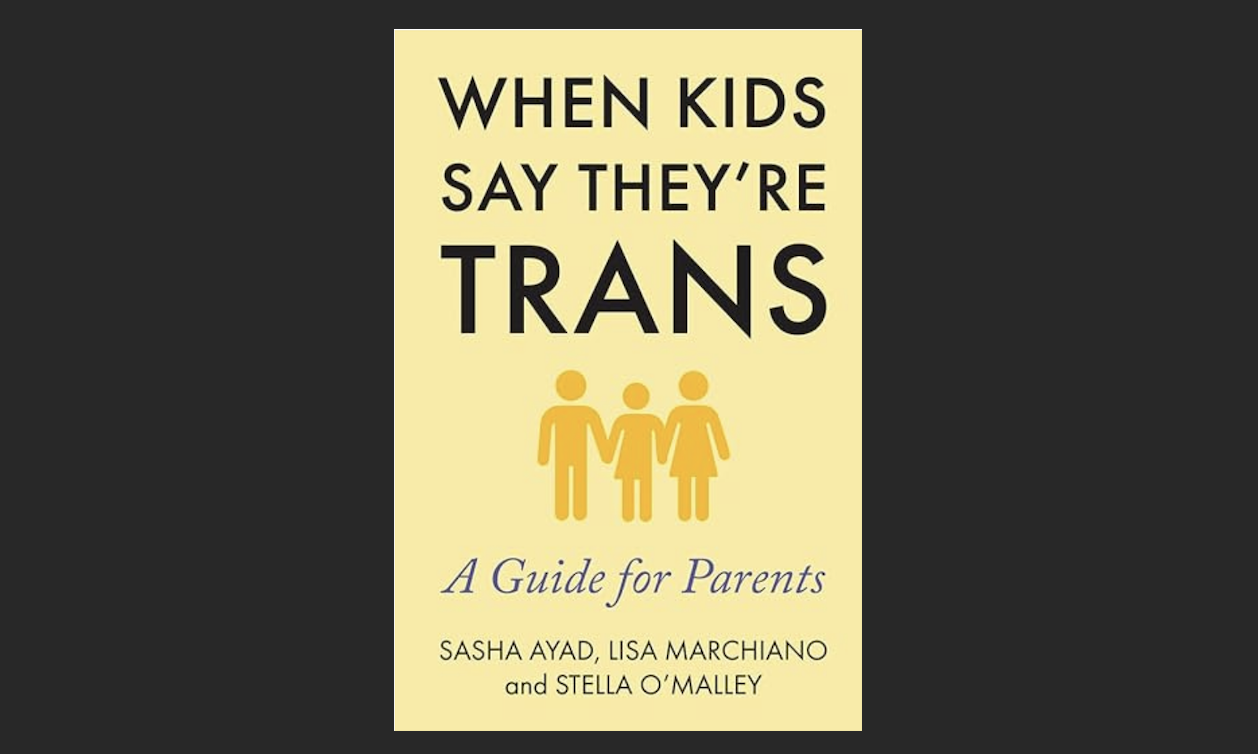When Kids Say They’re Trans
A new book explains how parents can help gender-distressed children who’ve come to believe they were ‘born in the wrong body.’

Parents of gender-questioning children—boys and girls who believe they might be “born in the wrong body”—typically fall into one of two camps. Either they enthusiastically embrace (or “affirm,” according to the preferred jargon) their child’s wish to transition to an opposite sex identification; or they have concerns, and would like to slow things down, so as to provide their child with more time to explore why they feel as they do.
Those who fall into the first category—the affirmation camp—will find no shortage of books, web sites, summer camps, social-media groups, therapists, activist organizations, (highly profitable) clinics, and even television shows available to help push their child along a path toward transition.
On the other hand, those who believe that hasty social and medical transition isn’t necessarily the best option for their child will find far fewer resources. In part, this is because many of those who’ve expressed alarm over the skyrocketing rates of trans-presenting children have been vilified in the media, within their families and peer groups, and online. They’ve been told that trans-presenting children will become suicidal if their beliefs are subject to even mild scrutiny. Many of the doctors who are supposed to support parents in keeping their children healthy have instead pressured mothers and fathers to go against their instincts.
These parents often come to realize they have few places to turn for real help. In some cases, they’re able to find a therapist who can deal thoughtfully with their child’s beliefs. But in other cases, they have to act as (in effect) their family’s own gender-dysphoria first responders.
For those parents, our message is: You can do this. You are the adults who are most deeply invested in your child’s flourishing. You have the widest perspective on his or her future potential and past difficulties. The advice that follows, based on experience we’ve accumulated helping families cope with this phenomenon, will help get you started on developing an authoritative, loving stance toward your gender-distressed child.
1. Don’t Let Others Gaslight YouTrust yourself. Trust your parental instincts built over the life of your child. Be careful about whom you recruit for help, and don’t let anyone gaslight you into believing that your viewpoint is phobic—even if they present their advice as the unassailably scientific consensus of impressive-sounding organizations. This is a relatively young field of research that has been largely dominated by ideologues and activists, not objective physicians. Nobody knows or loves your child more than you do, and thinking for yourself is crucial.
2. Mind Your Own Mental HealthThe fact that you are reading this—that you are open to facts and opinions about gender dysphoria that diverge from affirmation-based dogma—suggests that you are in the process of educating yourself. Perhaps you have already fallen into a research “rabbit hole,” and are spending every available hour reading about childhood gender dysphoria. This process of immersion often will include participation in online support and discussion groups populated by other parents who find themselves in the same situation.
Connecting with others can be a grounding experience. Humans are social creatures, and none of us like to feel isolated. It comes as a relief to know that you’re not the only parent who feels the way you do. On the other hand, it’s also easy to become overwhelmed by this process of immersion. And it can generate a process of mutual isolation within your own household, as you and your dysphoric child both come to inhabit different information silos. Your own mental health may come to decline in parallel with that of your child’s.
There will be sleepless nights, bouts of uncontrollable crying, and the onset of a difficult-to-describe sense of numbness. For many parents, dealing with a child’s assertion of a trans identity will mark the first time they’ve felt themselves lose control—and even a sense of authority—over their child’s care and safety. The resulting sense of powerlessness can feel terrifying.
Relationships become strained, especially if one’s partner takes a different approach. You need to take care of yourself and find balance, including by modelling the kind of self-awareness and behavioral moderation that you’re urging your child to apply. Attend the support group when it feels right. Avoid the support group when it doesn’t. Figure out what helps you stay grounded and allows you to lean in to this parenting challenge in a sustainable way. Build a routine of getting outdoors, eating well, exercising, reading novels, seeing trusted friends, and enjoying hobbies that help you restore your spirit. Do not lose yourself in the process of trying not to lose your child.
3. Be Firm in Describing the Truths of the WorldWhether your child is exhibiting actual signs of gender dysphoria, or is merely asserting that he or she is transgender, consider the potential root cause of the child’s gender discomfort (whether real or imagined). Decades ago, most observed pediatric cases of gender dysphoria occurred in early childhood. Multiple studies documented that the majority (upwards of 80%, though the exact figure is disputed) of such cases resolved by early adulthood—as long as a “watchful waiting” approach was followed, instead of an immediate program of social transition. Be mindful of the possibility that your child’s trans presentation may comprise a psychologically deflected means of dealing with other issues, such as homosexuality, trauma, or fear about his or her changing body.
As a parent, you can do much to help your child come to terms with his or her (unchangeable) biological sex. In this moment of crisis for your child, it may be tempting to accede to his or her beliefs about their “true” identity, on the basis that this will help relieve the child’s psychic distress. But this short-term strategy will only set your son or daughter up for disappointment in the long term, when the facts of biology become more evident. Biological sex is real. It isn’t “assigned at birth” by doctors.
We strongly advise against trying to enforce rigid gender norms, however. Many young children who express a desire for clothes and toys that are culturally associated with the opposite sex will grow up to be same-sex-attracted (i.e., gay or lesbian). Accepting a little boy’s preferences to dress up as a princess, without letting him lose sight of the fact that he is a boy, and that he will grow up to be a biological man, will help him accept himself for who he is (including, eventually, the possibility that he is gay).
Decide on household rules about presentation that you can implement and stick to. Some families freely allow gender-non-conforming boys to wear skirts and dresses at home, but require them to dress in a more gender-neutral fashion for school. In some cases, this is because, in today’s environment, a child who cross-dresses is simply assumed to be transgender; and so may be continually asked for his or her pronouns, or placed in groups with opposite-sex children, by educators and caregivers eager to demonstrate an enlightened attitude.
It’s sad to observe that nominally progressive teachers and day-care providers now enforce this kind of old-fashioned pink-and-blue logic when deciding who is a boy and who is a girl. But that is the reality many of us now inhabit. In the face of this kind of external pressure from ideologically motivated third parties, it may be easier for a young child to stay in touch with his or her biological reality if parents place limits on the way that he or she self-presents.
(If your son wants to experiment with make-up, it’s okay to explain that make-up is for grown-ups and teenagers. That said, it can be fun for children of either sex to get dressed up and play with cosmetics, nail polish, high-heeled shoes, and the like, even while acknowledging that, when it comes to daily usage, these generally aren’t appropriate for young children.)
4. Stay Vigilant—and PositiveFor children who are already gender-distressed, puberty is an especially difficult period, because the changes they observe in their bodies tend to create a painful sense of cognitive dissonance. This comes on top of the baseline anxieties that all children (especially girls) now feel about their bodies, thanks in large part to social media.
To take the focus off mere aesthetics, encourage your child to become proud of what his or her body can do—be it rowing, running, climbing, swimming, or other activities that are challenging, but whose mechanics don’t highlight sex differences in any obvious way. Spend time seeking out role models, in real life or online, who might resonate with your child—including men and women who are confident and successful even as they challenge gender norms.
Monitor what kind of influences your child is exposed to on the internet: Gender-non-conforming children are less likely to accept their bodies and genes if they are told by charismatic influencers that their souls are trapped in “the wrong body.” Over time, this propaganda can have the same effect as religious or cult indoctrination, which similarly promises troubled souls a form of psychic deliverance from their pains through a process of metaphorical rebirth.
If your child first asserts a trans identification while in middle or high school, you might wonder whether he or she has fallen under the influence of one or more trans-identified peers; or whether your child’s school is promoting “gender ideology” (for lack of a better term) as part of its curriculum. Peer-reviewed research suggests that many adolescents who assert a transgender identity in their tween or teenage years, without having previously exhibiting signs of gender distress (a phenomenon described in the literature as Rapid Onset Gender Dysphoria, or ROGD) are apt to emerge in clusters through a process of social contagion that some have analogized to anorexia.
Adolescence is a time when children push back against their parents and seek more autonomy, so it’s inevitable that a trans-identified child who demands immediate affirmation will regard your more cautious attitude as adversarial. But even so, it’s important that you don’t let this adversarial tone come to define your relationship. Beware of letting the gender issue crowd out every other issue in your child’s life. Don’t allow it to become a full-time battleground. Consider an 80/20 rule: the majority of your interactions with your child should have nothing to do with difficult gender talks.
The prospect of having fun with your child might seem far-fetched if your son or daughter has become withdrawn, moody, rude or sarcastic. But in most cases, there will be activities that the two of you can still enjoy together—such as baking, hiking, or watching your favorite show.
If your child is struggling with social, scholastic, or emotional concerns (whether or not you believe they are related to his or her gender distress), offer lots of loving support, and explore ways to address these difficulties. Find avenues to connect with your child, and to express your affection and parental pride. You might make space to talk about what is hard about being a boy (or girl), as well as what’s great about it. Remind them that there is no “right” way to be a girl or a boy. Our bodies just are, and we don’t get a say in the biological cards we were dealt. But those cards don’t dictate what interests we pursue, how we behave, or (most importantly) whom we love. Even within the limits that biology places upon us, we all still have plenty of autonomy when it comes to making these choices.
The type of interventions we are describing here may not work for all children—especially older ones. But it never hurts to at least try to encourage alternative interests, so that your child isn’t always dwelling on gender. One mother we know of, for instance, dealt with her son’s gender fixation as follows:
“Step by step, we helped him stretch. We started with individual activities (chess and composing lessons). Then group things: philosophy camp, chess club, wilderness camp. We were ‘unavailable’ for get-togethers with the [trans-identified] friend/s. I…removed the pro-trans channels from his Reddit feed…After six months, his trans behaviour started breaking up. After nine months, it was very inconsistent. Around fourteen months [in], he stopped shaving his legs. Finally, at around eighteen months, he cut his hair. Had we made it through? Around twenty-two months in, I gently asked where he was ‘with the whole gender identity thing.’ He responded, ‘Mom, I never want to talk about it again.’”5. Don’t Walk on Eggshells
There’s a temptation to walk on eggshells with a trans-identified child. But it’s usually better to combine respect with candor—not only in regard to biology, but in regard to your own mindset. Words like: I know you really want us to use different pronouns for you. This is something I’ve reflected on a lot, and it just feels inauthentic for me. We’ve always been honest with each other in the past. And I simply can’t refer to you in a way that feels like I’m lying to you, or being fake.
During discussions, try using open-ended questions, and avoid segueing into political debates that draw in references to external actors or culture-war protagonists. You are coming to these discussions as a parent, not as a spokesperson for any political party, author, or podcaster. Defend your own views, not those of anyone else.
Don’t accuse your child of being brainwashed (even if you suspect that may be the case), and listen intently. Thank your child for the moments when he or she is willing to talk in a sincere fashion.
Express an understanding of why your child might be seeking a new identity: I know you’re trying to feel better about yourself/find a peer group that feels right for you/create a sense of comfort in your body/carve out your own unique identity, etc. You should also give yourself license to make tentative observations that you acknowledge as such: I could be wrong, but it seems that part of what’s going on here may be that you’re trying to run away from yourself and become a new person.
It’s also fine to start conversations and end them inconclusively, disengaging when things are becoming heated or otherwise unproductive. A common element among many families that have dealt with a trans-presenting child successfully is that progress tends to come from many small conversations instead of one big one.
That said, your child should know where you stand on red-line issues—medical transition, most notably. If your adult child is no longer living at home, acknowledge his or her need for independence, but make room to share what you believe, especially the fact that it’s risky to change one’s identity and embark on medical transition, before resolving life’s other difficulties, developing financial stability, getting experience, and having healthy romantic relationships.
At the very least, this advice might help a teenage trans-identified child avoid joining the tragically long list of gender-distressed youth who end up in dire straits—even homeless—having single-mindedly pursued their transition dreams at the expense of everything else in life.
Some parents find that their child is so resistant to any dialogue that it is easier to avoid the subject of gender completely. You may be fearful that your child will cut all ties with you. In some cases, the child will have embraced the fairy-tale-style conceit that there is some “real” family out there that understands him or her in a way that you never could—a sort of “glitter family” or “queer house” where everyone is happy. (In this respect, it is notable that many trans-identified boys and men, in particular, tend to psychologically inhabit fantasy worlds based on Japanese cartoons and videogames that prominently feature androgynous child-like fairy creatures. In these online milieus, the trans world is sometimes presented metaphorically as a realm of youthful wizards, with their “cis”—i.e., non-trans—counterparts playing the role of gender muggles.)
In such cases, parents must carefully weigh the potential risk of total estrangement and proceed accordingly. If at all possible, it’s always best to provide a child with a sanctuary of some kind, in which parent and child can maintain some kind of functional relationship.
6. Maintain High ExpectationsAs noted above, when teens express distress through the language of gender, they often are channelling a separate core problem, such as trauma. Take some time to reflect on what such a problem might be. Is your child looking for a way to rebel and carve out his or her own identity? Is your child afraid of growing up, and so is subconsciously seeking a way to delay his or her maturity—including through the literal avoidance of puberty?
But even if you understand your child’s behaviour to reflect this kind of underlying anxiety, maintain high expectations of his or her behavior. Some young people spend a lot of time online arguing with strangers about their perceived verbal transgressions, a habit that can lead them to take on an air of intellectual superiority (and even invincibility). This can have anti-social consequences if they come to believe (as many do) that they can crush any dissent (including from their parents) with clever arguments or slogans. Dinnertime and other family gatherings then get ruined, as every disagreement or misspoken word is pounced upon as an excuse for a hectoring sermon. Make it clear that the strength of your child’s beliefs don’t relieve them of their duty to show respect to others.
Ask any questions you might have about your child’s beliefs and politics, but also protect your right to disagree about the answers; and, perhaps most importantly, protect your right to make mistakes (real or imagined) in articulating your position. The well-being of a family can unravel if children are allowed to dictate the rules of conversation, and so it is essential that you retain your sense of authority. (Also remember that other siblings are watching when these arguments take place, and will govern their own behaviour according to the precedents they observe.)
In some cases, a trans-identified child may be seeking a means to publicly express a desire for a better world in which marginalized populations get better treatment. The trans persona thereby becomes a sort of political statement—a gesture of solidarity with the larger LGBT community.
In such cases, your child may benefit from a broad exploration of the many issues involved in social justice, such as advocacy for the disabled, support for migrants, prisoners, and other vulnerable groups, efforts to help the environment, women’s rights, and so on. With some guidance and thoughtful conversation, parents may be able to gently nudge a child’s curiosity in such a way that his or her narrow focus on gender as a byword for social justice gets broadened out.
7. Consider a Lifestyle ShiftIf your resources permit, consider new experiences that push your child, and hopefully the entire family, beyond the ruts of day-to-day web surfing and bickering. Ideally, this would serve to expand your child’s sense of self.
Structured, age-appropriate travel opportunities, in particular, can offer a fantastic way for a child to develop a new perspective. Is there an option for a foreign-exchange program that allows your child to live with another family and become immersed in another language and culture? Are there volunteering opportunities that give your child a chance to contribute to society in a hands-on way, possibly away from home? It sometimes helps for a child to learn that the best way to help humanity usually involves face-to-face interaction, instead of spreading hashtags and arguing with strangers on Reddit.
Do you have (like-minded) family in another part of the country who might host your child for a spring or summer break? A rural environment can provide a novel experience for a child who’s spent his or her whole life in the city. Working with animals, enjoying nature, looking up at a sky full of stars, and learning new physical skills are all great ways to help develop a child’s understanding of the real world that exists outside his or her mind.
8. Mitigate Unhelpful InfluencesIf you’re already engaged in the strategies we’ve discussed so far, but have been undermined by other actors—such as an educator, therapist, or online personality who seeks to convince your child to equate parental concern with transphobia, it may be necessary to take further steps. In some cases, this can mean changing schools and therapeutic programs.
In the case of online influences, it might be helpful to educate your family about the need for digital wellness. The Social Dilemma, available on Netflix, discusses the ways in which social media algorithms hijack our attention. Share some of the ways in which you have felt drawn in by these technologies. Cutting down screen time, restricting apps, and implementing parental controls can be useful. Some families bring their computers into a common area during the evenings, and then limit the time they spend alone in their bedroom with devices. Encourage your child to use one-on-one text messaging when connecting with friends, instead of immersive social-media platforms; or, better still, encourage your child to spend more time with friends in person.
Once you have a plan, we recommend communicating your strategy to close family members, friends, and loved ones. If other adults in your child’s life cannot co-operate with you, or insist on undermining your parenting goals, you may find yourself with difficult decisions to make about those relationships. As we have witnessed, some adults have become so highly vested in gender ideology that they’ve come to believe that its precepts supersede the wishes and instructions communicated to them by parents.
Parting ways, at least temporarily, with these people can be a painful sacrifice. But nothing is more important than protecting your child’s welfare. And as with any important mission, success comes from creating a realistic plan, and making the decisions necessary to see it through.

Adapted, with permission, from When Kids Say They’re Trans: A Guide for Parents, by Sasha Ayad, Lisa Marchiano, and Stella O’Malley. Published by Pitchstone Publishing, in arrangement with Swift Press Ltd. Copyright © 2023 Sasha Ayad, Lisa Marchiano, and Stella O’Malley.











